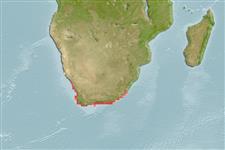Common names from other countries
Environment: milieu / climate zone / depth range / distribution range
Écologie
marin démersal. Subtropical; 27°S - 35°S
Southeast Atlantic: Lüderitzbucht, Namibia to East London, South Africa.
Taille / Poids / Âge
Maturity: Lm ? range ? - ? cm
Max length : 30.0 cm TL mâle / non sexé; (Ref. 5496)
Description synthétique
Clés d'identification | Morphologie | Morphométrie
Épines dorsales (Total) : 46 - 50; Rayons mous dorsaux (Total) : 2 - 4; Épines anales: 2; Rayons mous anaux: 33 - 37. Red or brown in color; large black blotch below 1st 3 dorsal spines; black dots around eye and on body (Ref. 5496). Juveniles black with red margins to dorsal, anal and caudal fins; small juveniles purple-black with a white caudal fin (Ref. 5496).
Found in pools and subtidal areas.
Life cycle and mating behavior
Maturities | Reproduction | Spawnings | Egg(s) | Fecundities | Larves
Smith, M.M., 1986. Clinidae. p. 758-769. In M.M. Smith and P.C. Heemstra (eds.) Smiths' sea fishes. Springer-Verlag, Berlin. (Ref. 5496)
Statut dans la liste rouge de l'IUCN (Ref. 130435)
CITES (Ref. 128078)
Not Evaluated
Menace pour l'homme
Harmless
Utilisations par l'homme
Outils
Articles particuliers
Télécharger en XML
Sources Internet
Estimates based on models
Preferred temperature (Ref.
115969): 16.1 - 22.2, mean 18.6 (based on 57 cells).
Phylogenetic diversity index (Ref.
82804): PD
50 = 0.7500 [Uniqueness, from 0.5 = low to 2.0 = high].
Bayesian length-weight: a=0.00513 (0.00223 - 0.01182), b=3.06 (2.86 - 3.26), in cm Total Length, based on LWR estimates for this (Sub)family-body shape (Ref.
93245).
Niveau trophique (Ref.
69278): 3.5 ±0.4 se; based on size and trophs of closest relatives
Résilience (Ref.
120179): Milieu, temps minimum de doublement de population : 1,4 à 4,4 années (Preliminary K or Fecundity.).
Fishing Vulnerability (Ref.
59153): Low vulnerability (20 of 100).
